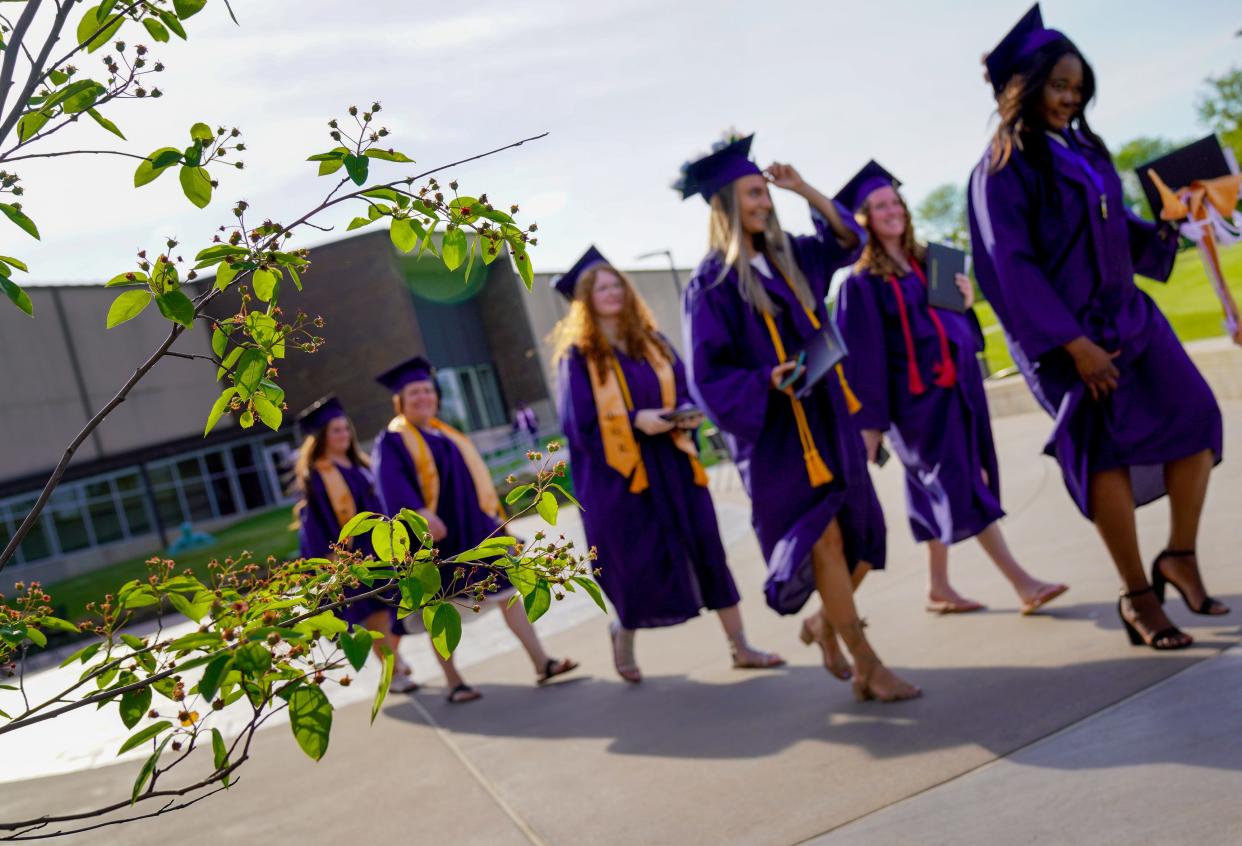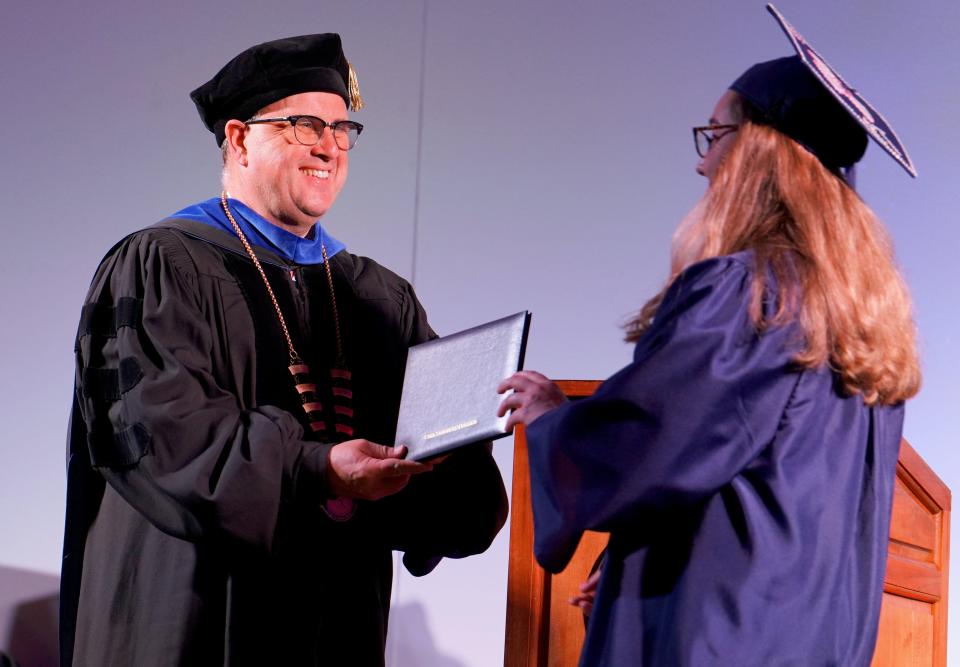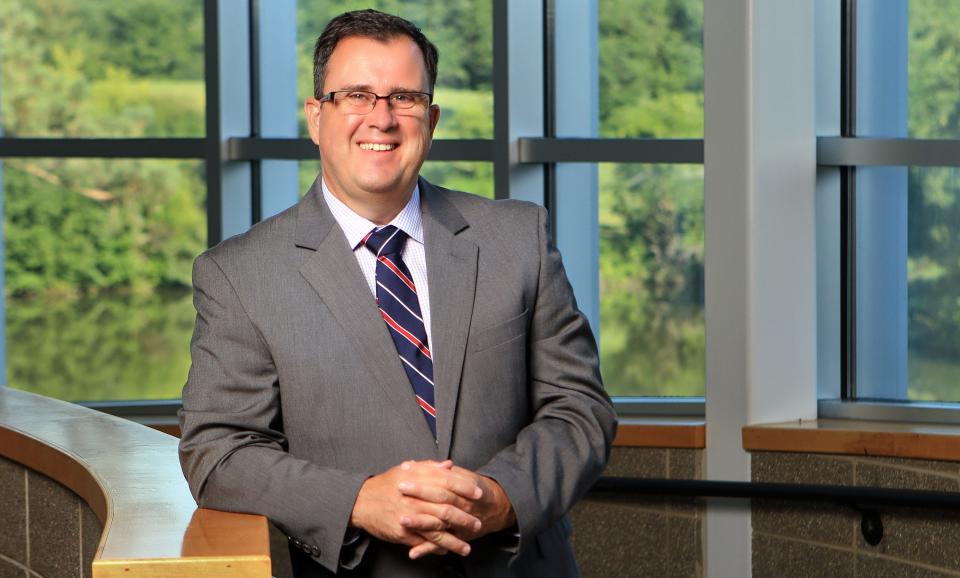What did pandemic do to community colleges? Sandburg, Blackhawk, others trying to recover

GALESBURG — Enrollment declined 10% each of the past two years at Carl Sandburg College, and other community colleges have been seeing similar decreases due to the pandemic.
A broader look shows that community colleges across the nation have seen enrollment losses. College leaders are working to reverse those numbers by navigating the breakdown of online vs. in person courses to return students.
Some students left college to join workforce
According to the Illinois Community College Board’s most recent annual report, the total headcount of students enrolled at Carl Sandburg College decreased by 10.2% from 2019 to 2020 and then 10.4% from 2020 to 2021.
Seamus Reilly, president of Carl Sandburg College, attributed part of the enrollment decline to the pandemic having a significant impact on the types of students who attend community colleges like Carl Sandburg.
Namely, he referred to older students who tend to have more family caregiving and work responsibilities than students at four-year colleges.
“Many of our students were front line workers because they were working in nursing homes or working in hospitals,” Reilly said. “Because of the shortage of people available to work, many of those students had to work many more hours and frankly, that's what caused many of our students to have to drop out of college.”
Reilly said Carl Sandburg College was never in “free fall.”
The college’s drop in enrollment was below the state’s average drop in enrollment that all Illinois community colleges have faced over the past five years, and about one percentage above the average decrease from 2019 to 2021.
According to the Illinois Community College board, the total headcount of students enrolled in Illinois community colleges decreased by 18.4% from 2019 to 2021 and the headcount of students enrolled full time decreased by 22.6% from the fall of 2017 to the fall of 2021.
Pandemic major driver of enrollment losses

Carl Sandburg graduation: Scenes from Carl Sandburg College’s 54th Commencement: May 2022
Matt Berry, chief of staff for the Illinois Community College Board, said many factors contributed to the enrollment declines at community colleges, but the pandemic has been the primary driver.
Shifting to remote learning made it difficult for students to learn certain career technical programs in a virtual environment, such as welding, and Berry said the pandemic created additional challenges to students who needed to work to provide for themselves or their families.
“Certainly our population that we serve are primarily students that are often adults, low income, may have found themselves out of work or taking care of children who were themselves doing remote learning,” Berry said. “(That) created a lot of challenges for people to pursue their educational paths.”
Heather Bjorgan, dean of enrollment management for Black Hawk College, echoed Reilly and Berry in saying that one of the reasons for Black Hawk’s drop in enrollment has been the pandemic challenging older students with families.
“Those stressors, the first thing to go is your own college pursuit because you're thinking about your family, your kids, your daily life,” Bjorgan said. “There's only so many hours a day and we heard that constantly from our students.”
Bjorgan noted that the job market has also impacted enrollment as students have foregone pursuing college in order to get a job. As a result, the breakdown of students who attend Black Hawk college with the intention to transfer to a four-year college or pursue certifications to enter the workforce has changed, with a 15-20% increase
Black Hawk College had 6,094 students in 2021 and Bjorgan estimated that there has been a 15-20% increase in the last couple of years of students seeking a career and technical education.
“They're wanting to jump into the workforce because the economic situation right now is such that wages are higher, jobs are more available, they can be choosier right now, there's a lot more opportunities and unemployment is low,” Bjorgan said. “That's the mix that we've seen changing, especially the last couple of years or so.”
Sandburg athletic awards: Two athletes, one coach claim inaugural 2021-22 Sandburg Athletics Awards
College leaders work to return students

Reilly said that applications for the upcoming fall 2022 term at Carl Sandburg College are up 33% compared to last year.
Though it is too early to tell whether the increase in applications will all yield enrolled students, the president said he is optimistic that Carl Sandburg College will be where it stood last year in enrollment: still down from the five year average but trending in the right direction.
In order to avoid more drops in enrollment, Reilly said that Carl Sandburg College is “not just waiting to see what happens” but is “constantly doing everything we can.
"We take advantage of opportunities for students with our (Galesburg) Promise Program so they can attend here for free, we have a very, very good foundation so there's lots of good opportunities for students, we're working closely with all of our high schools in our district as well as looking at students coming from outside the district,” Reilly said.
The president said that he is also optimistic that Carl Sandburg College will see students who have stepped back re-enter the college arena next year because as the economy changes, people might see why a credential is important or valuable.
“I think we had a lot of people who were in jobs where they might be making good money but those were temporary jobs,” Reilly said. “We had a lot of folks working in the service industry who suddenly were unemployed for much of the pandemic and maybe some of them are thinking, 'OK maybe it's time for me to go back to school and do something so that I'm not going to be at risk if I'm just working in the service industry.' "
Bjorgan said that she has told Black Hawk College’s board that since registration opened in April, the college will likely not hit the number of students it had in the fall of 2019 — which was 2,533 enrolled full time — but she is confident the college will have better numbers in the fall of 2022 than it did in the fall of 2020 or 2021.
There were 2,222 students enrolled full time at Black Hawk College in the fall of 2020 and 2,134 enrolled full time in the fall of 2021.
Fewer high school grads went on to college during pandemic
Bjorgan said that Black Hawk College has two main strategies it is pursuing to bring students back. The first is recruiting from an “untapped market” of students that graduated high school during the pandemic and, many frustrated with their experience with COVID mitigations, have waited to go on to college.
Bjorgan said that 50% percent of high school students who graduated in the Black Hawk district during the last two years have not gone on to college.
“We know that they’re sitting there waiting, they’ve probably jumped into the job market.” Bjorgan said. “We're saying, 'Look, it's time to come back now. This market, this job market is going to change over time. Your best strategy for your career and your life is to get to school now and work towards that long term goal."
Black Hawk College’s other primary strategy, Bjorgan said, is recruiting from its own population of students who stepped out during the pandemic.
"We're going after those groups saying, 'Look, we've got more on-campus classes, COVID mitigations have gone down a lot, it's a lot more accessible, we're here, let's get you back on track,’” Bjorgan said.
Berry said that the drop in enrollment in Illinois community colleges is really part of a national trend and that while enrollment has been decreasing for some time, there are early signs of hope.
“We are hopeful and optimistic that the decline is starting to be reversed," Berry said. "This last year while we did see a decline, percentage wise it was a much smaller decline than we've seen in previous years. So we're hearing just anecdotally that applications are up for next year, so we're hoping that translates to increased enrollment."
Online classes more than double at Sandburg
Though the breakdown of how many credit hours are in-person vs. online or hybrid shifts each semester at Carl Sandburg College, the school has doubled the amount of its online credit hours compared to before the pandemic.
Only 23% of Carl Sandburg’s credit hours were online in the fall of 2019 and 31% were online in the spring of 2019. More recently, 46% of Carl Sandburg’s College credit hours were online in the fall of 2021 and 56% were online in the spring of 2022.
Reilly said that Carl Sandburg College is now “reverting back to what’s more typical,” but that the college will also continue to expand its hybrid opportunities — credits that mix both online and in person classes each week.
The president said that early data shows adult students with more complex life balances were more successful in hybrid classes — classes which incorporated both in-person and online meetings each week — as there were fewer transportation or travel time barriers for students
Reilly said the college will mostly let students vote with their feet for what kind of classes they want and there is no specific percentage breakdown of online vs. in-person modality at which the college is aiming.
“Students ultimately decide which courses that they are going to choose to take, we just want to make sure that they have a lot of options available so students have some flexibility with their work life situation,” Reilly said.
Daniela Alcala, 22, is a current student at Carl Sandburg College who started taking classes there fully in person in 2019. She then transferred to Illinois Central College, a community college in Peoria in 2020 before returning to Sandburg in 2021. Her classes at ICC and Sandburg were fully online after 2020.
Alcala said she performed better with in-person classes because she appreciated being able to work hands-on in her classes and see her professors face-to-face. But as she lives in Monmouth, Alcala said she also experienced the benefit of not having to drive to her classes in Peoria when she studied online at ICC.
Overall, Alcala said she thinks it’s important that Carl Sandburg College continue to provide options for students and she appreciated that when she came back to Sandburg as a fully online student, it didn’t feel like she had lost any support.
“That's one of the things I like about Sandburg is even though when I left everything was in person and then when I came back everything was online, I noticed that when I was on campus to talk to my advisors, everything seemed the same way,” Alcala said. “Everybody was still extremely helpful, everybody reached out.”
At Black Hawk College, the number of credits offered online were 18% percent in the fall of 2019. In the fall of 2021, 54% of the college’s credits were offered online and in the spring of 2022, 40% of credits offered were online.
Market will determine offerings, whether online or in-person
Similar to Carl Sandburg College, Bjorgan said that Black Hawk College is not trying to reach a specific number for its breakdown of online versus in-person offerings in the coming years. But Bjorgan also said that if online or hybrid classes make it easier for students to get an education amid high gas prices, Black Hawk College wants to be responsive to that.
“When we see things filling more towards online in a certain class we might open up another section and we'll keep it online. If we see things filling more towards in person in a certain class, we'll open up another section in person. But that market is going to drive what we do," Bjorgan said.
“We're not trying to hit a certain thing, we're not saying words like, ‘We want to go back to anything.’ We know we're in a new world order here in terms of community college access.”
This article originally appeared on Galesburg Register-Mail: Carl Sandburg College sees more students leaving for workforce

